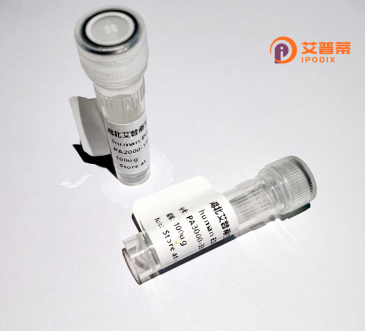
| 纯度 | >90%SDS-PAGE. |
| 种属 | Human |
| 靶点 | ASAP1 |
| Uniprot No | Q9ULH1 |
| 内毒素 | < 0.01EU/μg |
| 表达宿主 | E.coli |
| 表达区间 | 1-36aa |
| 氨基酸序列 | MNAHLSDVLKHPLHPFFIIFLVLFLDKFKLLKDYSR |
| 分子量 | 4 kDa |
| 蛋白标签 | GST-tag at N-terminal |
| 缓冲液 | 冻干粉 |
| 稳定性 & 储存条件 | Lyophilized protein should be stored at ≤ -20°C, stable for one year after receipt. Reconstituted protein solution can be stored at 2-8°C for 2-7 days. Aliquots of reconstituted samples are stable at ≤ -20°C for 3 months. |
| 复溶 | Always centrifuge tubes before opening.Do not mix by vortex or pipetting. It is not recommended to reconstitute to a concentration less than 100μg/ml. Dissolve the lyophilized protein in distilled water. Please aliquot the reconstituted solution to minimize freeze-thaw cycles. |
以下是关于ASAP1的3-4篇代表性文献的简要概括:
1. **文献名称**:*ASAP1. a regulator of Arf GTPase activity, controls cell migration through modulation of Rac1*
**作者**:Randazzo PA 等
**摘要**:该研究揭示了ASAP1通过其Arf-GAP结构域调控Arf1和Arf5的GTPase活性,进而影响细胞膜动力学和Rac1信号通路,最终促进肿瘤细胞的迁移和侵袭能力。
2. **文献名称**:*ASAP1 modulates the structural dynamics of invadopodia in breast cancer cells*
**作者**:Bharti S 等
**摘要**:研究发现ASAP1通过调控Arf6活性,影响细胞膜骨架重组,促进乳腺癌细胞侵袭性伪足(invadopodia)的形成,增强细胞外基质降解能力。
3. **文献名称**:*Crystal structure of the Arf-GAP domain of ASAP1 and its role in GTP hydrolysis*
**作者**:Nie Z 等
**摘要**:通过解析ASAP1的Arf-GAP结构域晶体结构,揭示了其催化Arf-GTP水解的分子机制,并发现PH结构域与脂质结合后对该活性的空间调控作用。
4. **文献名称**:*ASAP1 promotes tumor progression by regulating EMT in hepatocellular carcinoma*
**作者**:Kumar D 等
**摘要**:研究证实ASAP1在肝细胞癌中高表达,通过激活PI3K/AKT通路促进上皮-间质转化(EMT),从而增强肿瘤细胞的转移潜能和化疗耐药性。
这些研究涵盖ASAP1的分子机制、结构基础及其在癌症中的功能,可作为研究该蛋白的起点。
ASAP1 (Arf-GAP with SH3 Domain, Ankyrin Repeat, and PH Domain 1) is a multidomain protein that belongs to the ARF GTPase-activating protein (Arf-GAP) family. It regulates the cycling of ARF GTPases between active (GTP-bound) and inactive (GDP-bound) states, thereby influencing membrane trafficking, cytoskeletal reorganization, and cellular signaling. Characterized by its modular structure, ASAP1 contains an N-terminal BAR domain for membrane curvature sensing, a PH domain for phosphoinositide binding, an Arf-GAP catalytic domain, ankyrin repeats, and a C-terminal SH3 domain that mediates protein-protein interactions.
ASAP1 is implicated in diverse cellular processes, including integrin-mediated cell adhesion, receptor endocytosis, and invadopodia formation. Dysregulation of ASAP1 has been linked to pathological conditions such as cancer metastasis, where it promotes tumor cell migration, invasion, and extracellular matrix remodeling by modulating integrin trafficking, cytoskeletal dynamics, and signaling pathways like Src and FAK. Additionally, genetic polymorphisms in ASAP1 are associated with susceptibility to infectious diseases, including tuberculosis, suggesting roles in immune regulation. Studies using recombinant human ASAP1 have advanced understanding of its biochemical activity, structural interactions, and therapeutic potential, making it a focal point in cancer and infectious disease research.
×